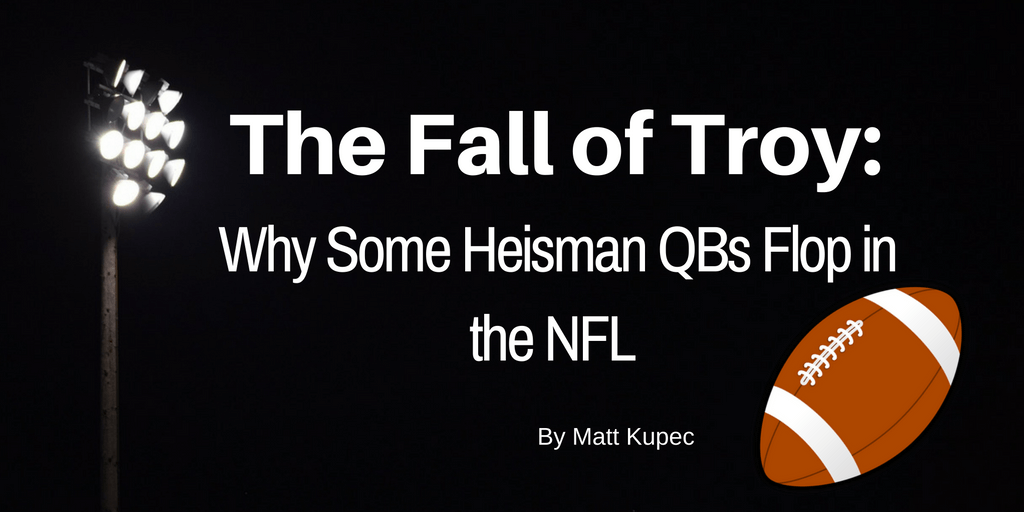Troy James Smith was a superstar under center at Ohio State University. He was a unanimous All-American, named a Sporting News Player of the Year, AP Player of the Year and Heisman Trophy winner in 2006. ESPN called called him the “Big 10 Player of the Decade.” Troy James Smith, at age 22, was an electric athlete capable of filling the 104,000 seats at Ohio Stadium on his own.
Now Troy Smith–the same Troy Smith–is out of football entirely after being drafted in the fifth round in 2007 and winning just 8 games in his career. And his case certainly isn’t an exception.
Despite lighting up defenses on a weekly basis for four years at Ohio State, Smith wasn’t a highly touted NFL prospect. Exactly 173 college athletes were drafted ahead of him in 2007; 32 eventual Pro Bowlers were taken ahead of him, just two were taken after. The 174 draft slot doesn’t carry a lot of clout, particularly for a quarterback, even a Heisman Trophy winning QB.
So why do so many QBs who excel at the collegiate level fail to transition their game to the NFL?
The Level of Competition
This is the most simple and straightforward reason that so many young QBs fail at the NFL level. When players like Troy Smith or Matt Leinart are lighting up college defenses, they’re outsmarting people as young as 18 years old. They’re outsmarting men fresh out of high school who don’t have the size or the speed or the intelligence of NFL players.
In the NFL that’s not the case. When 22 year old Troy Smith excelled his senior year, he was doing so against a group of individuals who in large part were just college athletes. Players who didn’t have the talent to go pro, those who were going to play football for a few years before setting into a desk job somewhere. Then, when that same Troy Smith took his first NFL snap, he was playing against the best of the best. The level of competition increases tremendously during that transition, and is often too much for young people to handle in stride.
The Coaching
College coaches approach football not with the idea to prepare their players for futures in the NFL, but to win college games. Does building a strong NFL rap sheet reflect well on a coach and the system, sure, but the main priority for an NCAA coach is to win games.
Players aren’t coached on how to adapt to NFL defenses, they’re coached on how to exploit flimsy college ones; flimsy college defenses that are far, far inferior to anything seen in the NFL.
The Speed and Style of the Game
You hear this alluded to so often as younger quarterbacks begin to make that transition into a role with an NFL team. The speed and style of an NFL game far out class anything seen in college football. And while there are NCAA QBs who will excel of course–the next Tom Brady or Peyton Manning is certainly out there somewhere–the style of play in college can also dictate the level of success he’ll see in the pros. Players like Smith have a few major drawbacks that they can get away with in college: small stature (mitigated by speed) and poor decision making (mitigated by shoddy defenses).
College QBs who excel are able to make up for relatively poor accuracy by utilizing their speed and exploiting poor defenses, but at the NFL level, those flaws don’t exist. Scrambling quarterbacks no longer have a huge edge because linebackers, DBs and linemen in the NFL have the speed to catch them, and the tools and intelligence to capitalize on those flaws.
Every NFL draft is rife with players who will inevitably flop. High round talent that simply doesn’t pan out. Troy Smith is not an example; as a player who played incredibly in college but was properly scouted as a late-round QB, Smith is a great example of the differing styles and levels of play between the NFL and college and why some simply can’t compete.

